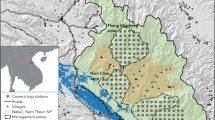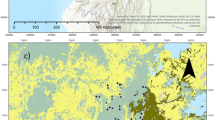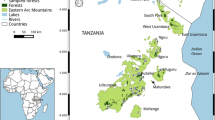Abstract
Exploring factors related to species distribution is important to better understand their natural histories and provide their effective conservation. However, the ecology of some threatened species remains poorly understood. Here, we conducted the first quantitative investigation of species-habitat relationships for the Brazilian three-banded armadillo, Tolypeutes tricinctus, a threatened species endemic to Brazil. We combined camera traps and active searches to explore the influence of ecological and methodological factors, including human-related habitat features, on T. tricinctus occupancy and detection probabilities in a human-modified landscape in northeastern Brazil. The T. tricinctus occupancy probability was high throughout the study area, whereas its detection probability was eight times higher by active searches than camera trap**, which should be considered when designing studies on T. tricinctus ecology in the future. Our results suggest that T. tricinctus can be widely distributed in human-modified landscapes under moderate levels of hunting and habitat loss and highlight the importance of the engagement of local people into research and conservation projects for better outcomes, as we found by counting on their local ecological knowledge for the conduction of active searches.

Similar content being viewed by others
Data availability
All data used for analysis is cited in the text, available as Online Resource, and/or available from the authors on request.
Code availability
Not applicable.
References
Attias N, Miranda FR, de Sena LMM et al (2016) Yes, they can! Three-banded armadillos Tolypeutes sp. (Cingulata: Dasypodidae) dig their own burrows. Zoologia (Curitiba) 33:e20160035. https://doi.org/10.1590/S1984-4689zool-20160035
Bocchiglieri A, Mendoncça AF, Henriques RPB (2010) Composição e diversidade de mamíferos de médio e grande porte no Cerrado do Brasil central. Biota Neotrop 10:169–176. https://doi.org/10.1590/s1676-06032010000300019
Burnham KP, Anderson DR (2002) Model selection and multimodel inference: a practical information-theoretic approach, 2nd edn. Springer-Verlag, New York
Campos CB, Esteves CF, Dias DM, Rodrigues FHG (2019) Medium and large sized mammals of the Boqueirão da Onça, North of Bahia State Brazil. Pap Avulsos Zool 59:e20195912. https://doi.org/10.11606/1807-0205/2019.59.12
Cuéllar E (2008) Biology and ecology of armadillos in the Bolivian Chaco. In: Vizcaíno SF, Loughry WJ (eds) The biology of the Xenarthra. University Press of Florida, Gainesville, pp 306–312
Dias DM, Massara RL, Campos CB, Rodrigues FHG (2019) Human activities influence the occupancy probability of mammalian carnivores in the Brazilian Caatinga. Biotropica 51:253–265. https://doi.org/10.1111/btp.12628
Dias DM, Ferreguetti AC, Rodrigues FHG (2020) Using an occupancy approach to identify poaching hotspots in protected areas in a seasonally dry tropical forest. Biol Conserv 251:108796. https://doi.org/10.1016/j.biocon.2020.108796
Dobbins M, Sollmann R, Menke S et al (2020) An integrated approach to measure hunting intensity and assess its impacts on mammal populations. J Appl Ecol 57:2100–2111. https://doi.org/10.1111/1365-2664.13750
Donagema GK, de Campos DVB, Calderano SB et al (2011) Manual de métodos de análises de solos, 2nd edn. Embrapa Solos, Rio de Janeiro
Feijó A, Garbino GST, Campos BATP et al (2015) Distribution of Tolypeutes Illiger, 1811 (Xenarthra: Cingulata) with comments on its biogeography and conservation. Zool Sci 32:77–87. https://doi.org/10.2108/zs140186
Ferreguetti AC, Tomas WM, Bergallo HG (2016) Density and niche segregation of two armadillo species (Xenarthra: Dasypodidae) in the Vale Natural Reserve, Brazil. Mamm Biol 81:138–145. https://doi.org/10.1016/j.mambio.2015.10.007
Fleischner TL (1994) Ecological costs of livestock grazing in western North America. Conserv Biol 8:629–644. https://doi.org/10.1046/j.1523-1739.1994.08030629.x
Gibb GC, Condamine FL, Kuch M et al (2016) Shotgun mitogenomics provides a reference phylogenetic framework and timescale for living xenarthrans. Mol Biol Evol 33:621–642. https://doi.org/10.1093/molbev/msv250
Hannibal W, Zortéa M, Calaça AM et al (2021) Checklist of mammals from Goiás, central Brazil. Biota Neotrop 21:e20201173. https://doi.org/10.1590/1676-0611-BN-2020-1173
Helldin JO, Jung J, Neumann W et al (2012) Effects of wind power on terrestrial mammals: a synthesis. Swedish Environmental Protection Agency, Bromma
Hines, JE (2006) PRESENCE - Software to estimate patch occupancy and related parameters. USGS-PWRC. http://www.mbr-pwrc.usgs.gov/software/presence.html. Accessed 17 Oct 2021
ICMBio – Instituto Chico Mendes de Conservação da Biodiversidade (2014) Sumário Executivo do Plano de Ação Nacional para a Conservação do Tatu-bola. ICMBio/MMA, Brasília.
Jonzén N (2008) Habitat selection: implications for monitoring, management, and conservation. Isr J Ecol Evol 54:459–471. https://doi.org/10.1560/IJEE.54.3-4.459
Lebreton J, Burnham KP, Clobert J, Anderson DR (1992) Modeling survival and testing biological hypotheses using marked animals: a unified approach with case studies. Ecol Monogr 62:67–118. https://doi.org/10.2307/2937171
MacKenzie DI, Bailey LL (2004) Assessing the fit of site-occupancy models. J Agric Bio Environ Stat 9:300–318. https://doi.org/10.1198/108571104X3361
MacKenzie DI, Nichols JD, Lachman GB et al (2002) Estimating site occupancy rates when detection probabilities are less than one. Ecology 83:2248–2255. https://doi.org/10.1890/0012-9658(2002)083[2248:ESORWD]2.0.CO;2
Magalhães RA, de Sena LMM, Rodrigues FHG (2021) First records of Brazilian three-banded armadillo (Tolypeutes tricinctus, Mammalia, Cingulata, Chlamyphoridae) predation by jaguar (Panthera onca, Mammalia, Carnivora, Felidae). Pap Avulsos Zool 61:e20216158. https://doi.org/10.11606/1807-0205/2021.61.58
Marinho-Filho J, Reis ML (2008) Tolypeutes tricinctus Linnaeus, 1758. In: Chiarello AG, Aguiar LMS, Cerqueira R (eds) Livro vermelho da fauna brasileira ameaçada de extinção. MMA/Biodiversitas, Brasília/Belo Horizonte, pp 709–710
Marinho-Filho J, Guimarães M, Reis ML et al (1997) The discovery of the Brazilian three-banded armadillo in the Cerrado of Central Brazil. Edentata 3:11–13
McDonough CM, Loughry W (2008) Behavioral ecology of armadillos. In: Vizcaíno SF, Loughry WJ (eds) The biology of the Xenarthra. University Press of Florida, Gainesville, pp 281–293
Miranda F, Moraes-barros N, Superina M, Abba AM (2014) The IUCN red list of threatened species. Tolypeutes tricinctus, Brazilian three-banded armadillo. https://www.iucnredlist.org/species/21975/47443455. Accessed 17 Oct 2021
MMA – Ministério do Meio Ambiente (2017) 2a atualização das Áreas Prioritárias para Conservação da Biodiversidade 2018. http://areasprioritarias.mma.gov.br/2-atualizacao-das-areas-prioritarias. Accessed 9 Sep 2021
Neri M, Jameli D, Bernard E, Melo FPL (2019) Green versus green? Adverting potential conflicts between wind power generation and biodiversity conservation in Brazil. Perspect Ecol Conserv 17:131–135. https://doi.org/10.1016/j.pecon.2019.08.004
Noss AJ, Cuéllar RL, Cuéllar E (2008) Exploitation of xenarthrans by the Guaraní-Isoseño indigenous people of the Bolivian Chaco: comparisons with hunting by other indigenous groups in Latin America, and implications for conservation. In: Vizcaíno SF, Loughry WJ (eds) The biology of the Xenarthra. University Press of Florida, Gainesville, pp 244–254
Porfirio G, Sarmento P, Filho NLX et al (2014) Medium to large size mammals of southern Serra do Amolar Mato Grosso do Sul Brazilian Pantanal. Check List 10:473–482. https://doi.org/10.15560/10.3.473
Projeto Mapbiomas (2021). Coleção 5 da série anual de mapas de cobertura e uso de solo do Brasil. https://mapbiomas.org/en/colecoes-mapbiomas-1?cama_set_language=en. Accessed 9 Sep 2021
QGIS Development Team (2021) QGIS Geographic Information System. OpenSource Geospatial Foundation Project. http://qgis.osgeo.org. Accessed 5 Oct 2022
Regolin AL, Oliveira-Santos LG, Ribeiro MC, Bailey LL (2021) Habitat quality, not habitat amount, drives mammalian habitat use in the Brazilian Pantanal. Landscape Ecol 36:2519–2533. https://doi.org/10.1007/s10980-021-01280-0
Reis ML, Chiarello AG, Campos CB et al (2015) Avaliação do risco de extinção de Tolypeutes tricinctus (Linnaeus, 1758) no Brasil. In: ICMBio – Instituto Chico Mendes de Conservação da Biodiversidade (ed) Avaliação do risco de extinção de xenartros brasileiros. ICMBio, Brasília, pp 237–248
Rhodes JR, Lunney D, Moon C et al (2011) The consequences of using indirect signs that decay to determine species’ occupancy. Ecography 34:141–150. https://doi.org/10.1111/j.1600-0587.2010.05908.x
Rodrigues TF, Chiarello AG (2018) Native forests within and outside protected areas are key for nine-banded armadillo (Dasypus novemcinctus) occupancy in agricultural landscapes. Agric Ecosyst Environ 266:133–141. https://doi.org/10.1016/j.agee.2018.08.001
Rowcliffe JM, Carbone C, Jansen PA et al (2011) Quantifying the sensitivity of camera traps: an adapted distance sampling approach. Methods Ecol Evol 2:464–476. https://doi.org/10.1111/j.2041-210X.2011.00094.x
Santos IB, da Fonseca GAB, Rigueira SE, Machado RB (1994) The rediscovery of the Brazilian three banded armadillo and notes on its conservation status. Edentata 1:11–15
Santos JC, Leal IR, Almeida-Cortez JS et al (2011) Caatinga: the scientific negligence experienced by a dry tropical forest. Trop Conserv Sci 4:276–286. https://doi.org/10.1177/194008291100400306
Santos PM, Bailey LL, Ribeiro MC et al (2019a) Living on the edge: forest cover threshold effect on endangered maned sloth occurrence in Atlantic Forest. Biol Conserv 240:108264. https://doi.org/10.1016/j.biocon.2019.108264
Santos PM, Bocchiglieri A, Chiarello AG et al (2019b) Neotropical xenarthrans: a data set of occurrence of xenarthran species in the Neotropics. Ecology 100:e02663. https://doi.org/10.1002/ecy.2663
Schetino MAA, Campos DP, Anacleto TCS, Santos FR (2021) New records of Tolypeutes tricinctus Linnaeus, 1758 (Cingulata: Tolypeutinae) in northern Minas Gerais state, Brazil. Lundiana 14:01–04
SEI – Superintendência de Estudos Econômicos e Sociais da Bahia (2014). Tipologia climática Köppen. SEI, Salvador
Silveira L, Jácomo ATA, Diniz-Filho JAF (2003) Camera trap, line transect census and track surveys: a comparative evaluation. Biol Conserv 114:351–355. https://doi.org/10.1016/S0006-3207(03)00063-6
Superina M, Abba AM (2020) Conservation perspectives for a highly disparate lineage of mammals: the Xenarthra. Mastozool Neotrop 27:48–67
Superina M, Pagnutti N, Abba AM (2014) What do we know about armadillos? An analysis of four centuries of knowledge about a group of South American mammals, with emphasis on their conservation. Mammal Rev 44:69–80. https://doi.org/10.1111/mam.12010
Taber FW (1945) Contribution on the life history and ecology of the nine-banded armadillo. J Mammal 26:211–226
Trombulak SC, Frissell CA (2000) Review of ecological effects of roads on terrestrial and aquatic communities. Conserv Biol 14:18–30. https://doi.org/10.1046/j.1523-1739.2000.99084.x
Tudge SJ, Brittain S, Kentatchime F, et al (2022) The impacts of human activity on mammals in a community forest near the Dja Biosphere Reserve in Cameroon. Oryx 1–9. https://doi.org/10.1017/S0030605321000806
White GC, Burnham KP (1999) Program mark: survival estimation from populations of marked animals. Bird Study 46:120–139
Acknowledgements
The companies Azurit Engenharia and Statkraft provided logistical support in the study area. We thank the field assistants Cosme, Lourisvaldo, and Olavo for their indispensable help with field activities.
Funding
This work was supported by the Arizona Center for Nature Conservation (ACNC)/Phoenix Zoo Conservation & Science Grant Program, Coordenação de Aperfeiçoamento de Pessoal de Nível Superior (CAPES) [grant numbers: 88887.199565/2018–00; 88882.316024/2019–01], and Conselho Nacional de Desenvolvimento Científico e Tecnológico (CNPq) [grant number: 301289/2019–0].
Author information
Authors and Affiliations
Contributions
Conceptualization: Rodolfo A. Magalhães, Rodrigo L. Massara, Fábio S. de Oliveira, and Flávio H. G. Rodrigues. Methodology: Rodolfo A. Magalhães, Rodrigo L. Massara, Fábio S. de Oliveira, and Flávio H. G. Rodrigues. Formal analysis and investigation: Rodolfo A. Magalhães, Rodrigo L. Massara, and Fábio S. de Oliveira. Writing — original draft preparation: Rodolfo A. Magalhães. Writing — review and editing: Rodrigo L. Massara, Fábio S. de Oliveira, and Flávio H. G. Rodrigues. Funding acquisition: Rodolfo A. Magalhães, Rodrigo L. Massara, and Flávio H. G. Rodrigues.
Corresponding author
Ethics declarations
Ethics approval
Not applicable.
Consent to participate
Not applicable.
Consent for publication
Not applicable.
Competing interests
The authors declare no competing interests.
Additional information
Communicated by Thales Renato Ochotorena de Freitas.
Publisher's Note
Springer Nature remains neutral with regard to jurisdictional claims in published maps and institutional affiliations.
Supplementary Information
Below is the link to the electronic supplementary material.
Rights and permissions
Springer Nature or its licensor holds exclusive rights to this article under a publishing agreement with the author(s) or other rightsholder(s); author self-archiving of the accepted manuscript version of this article is solely governed by the terms of such publishing agreement and applicable law.
About this article
Cite this article
Magalhães, R.A., Massara, R.L., de Oliveira, F.S. et al. The Brazilian three-banded armadillo is widely distributed in a human-modified landscape in northeastern Brazil. Mamm Res 68, 53–62 (2023). https://doi.org/10.1007/s13364-022-00651-5
Received:
Accepted:
Published:
Issue Date:
DOI: https://doi.org/10.1007/s13364-022-00651-5




